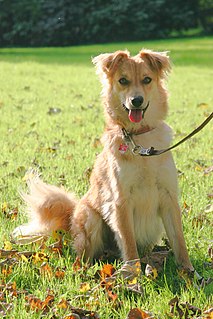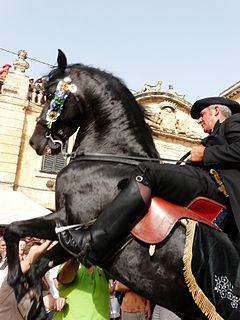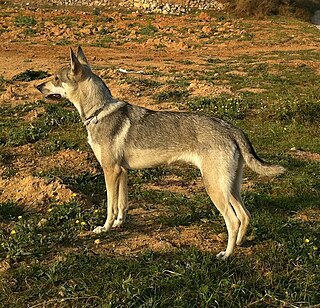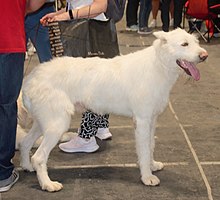
The Presa Canario is a Spanish breed of large dog of mastiff or catch dog type. It originates in the autonomous region of the Canary Islands, and is found mostly in the islands of Gran Canaria and Tenerife. It was formerly known as the Dogo Canario. It was traditionally used as a guard dog, as a herding dog for both sheep and cattle, and for dog-fighting, which was legal in Spain until 1936 and may have continued clandestinely thereafter.

The Alano Español or Spanish Bulldog is a Spanish breed of medium to large sized dog of alaunt-bulldog type. It has at various times been used as a war dog, for bullfighting, for the management of cattle, for hunting and as a guard dog.

The Basque Shepherd Dog, Basque: Euskal Artzain Txakurra, Spanish: Perro de Pastor Vasco, is a traditional Spanish breed of sheepdog originating in the historic Basque Country. It is believed that they originated from Central European herding dogs.

The Mallorquín or Caballo Mallorquín is a rare breed of horse indigenous to the island of Mallorca in the Balearic Islands, from which it takes its name. Identification of the breed was begun in 1981 by the Patronato para las Razas Autóctonas de Mallorca. The Mallorquín is listed in the Catálogo Oficial de Razas de Ganado de España in the group of autochthonous breeds in danger of extinction.

The Pachón Navarro is a Spanish breed of hunting dog from the autonomous community of Navarre, in northern Spain. It is one of five Basque breeds of dog, the others being the Basque Shepherd Dog, the Erbi Txakur, the Villano de Las Encartaciones and the Villanuco de Las Encartaciones.

The Can de Palleiro is a traditional Spanish breed of shepherd dog from the autonomous province of Galicia in north-western Spain. It was recognised by royal decree in 2001, and the stud-book was established in the same year. It is named after the haystack near which it traditionally sleeps.

The Burguete is a Spanish breed of horse from the autonomous community of Navarre in north-eastern Spain. It is listed in the Catálogo Oficial de Razas de Ganado de España in the group of autochthonous breeds in danger of extinction. It is reared principally for horsemeat.

The Menorquín or Catalan: Cavall Menorquí is a breed of horse indigenous to the island of Menorca in the Balearic Islands, from which it takes its name. It is closely associated with the doma menorquina style of riding.

The Euskal Oiloa, Spanish: Gallina Vasca, is a breed of domestic chicken from the autonomous community of the Basque Country in north-eastern Spain and south-western France. It is the traditional rural chicken of the area, a rustic dual-purpose breed of Atlantic type, and differs from Mediterranean Spanish breeds such as the Castellana Negra and the Minorca in several respects: it has yellow legs and feet, red earlobes, and lays brown eggs.
The Pasiega is a traditional Spanish breed of red dairy cattle from the autonomous community of Cantabria in northern Spain. It originated in the Valles Pasiegos in south-eastern Cantabria. The name derives from that of the Pas River, which flows through that region. Because of the colour of its coat it may also be known as the Roja Pasiega or Rojina.

The Ca Rater Mallorquí or Spanish: Ratonero mallorquín is a Spanish breed of dog of ratter type, found on the island of Mallorca in the Balearic Islands.

The Ca Mè Mallorquí is a Spanish breed of pointing dog originating in the Mediterranean island of Mallorca, in the Balearic Islands. It was traditionally used as a pointing dog in hunting. It was officially recognised by the national government of Spain in 2004, but is not recognised by either the Fédération Cynologique Internationale or the Real Sociedad Canina de España.

The Palmera is an endangered breed of cattle from the island of San Miguel de La Palma, in the Spanish autonomous community of the Canary Islands. The cattle are not indigenous to the island, but were brought by European settlers in the fifteenth century. The Palmera derives from the Rubia Gallega breed of Galicia. It is distributed mostly in the municipalities of Breña Alta, Breña Baja, El Paso, Garafía, Los Llanos de Aridane and Villa de Mazo, with small numbers in the municipalities of Puntagorda, Santa Cruz de La Palma and Tijarafe; a few may be found on the islands of Fuerteventura and Tenerife.

The Lobito Herreño or Perro de Pastor Herreño is a Spanish breed or type of pastoral dog. It is found mostly on the island of El Hierro in the Canary Islands, but also on Gran Canaria, La Palma and Tenerife. It is not recognised as breed by the Real Sociedad Canina de España, but in 2021 was one of three breeds or types listed as a grupo étnico canino, which the society defines as a regional dog population with consistent form and function evolved through functional selection. The other two dogs in this group are the Podenco Orito Español and the Carea Castellano-Manchego.
The Perdigueiro Galego is a rare breed of pointer from the autonomous community of Galicia in north-western Spain. It is one of four traditional breeds of the region, the others being the Can de Palleiro, the Guicho or Quisquelo, and the Podengo Galego.

The Monchina, Basque: Behi montxina, is a Spanish breed of mountain cattle indigenous to the autonomous communities of Cantabria and the Basque Country in northern Spain. It is related to the Betizu and possibly to the Terreña breeds of cattle of the Basque Country, and is closely associated with the Villano de las Encartaciones breed of dog, which is traditionally used in managing it. It is classified by the Ministerio de Agricultura, Pesca y Alimentación, the Spanish ministry of agriculture, as a "Raza Autóctona en Peligro de Extinción" or native breed at risk of extinction.

The Azpi Gorri is a traditional Spanish breed of domestic goat. It originates in the historical Basque Country, and is the only recognised goat breed of that area. It is distributed in the northern part of the province of Álava and in southern Bizkaia, with a few herds in the autonomous community of Navarre.
The Euskal Antzara is a traditional Spanish breed of domestic goose. It originates in the historical Basque Country. It is the only recognised goose breed of that area, and one of two Spanish breeds of goose, the other being the Oca Empurdanesa. It is distributed mainly in the comarca of Enkarterri in the province of Bizkaia, particularly in the areas of Abanto, Balmaseda, Güeñes, Karrantza and Zalla.















